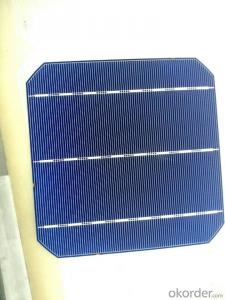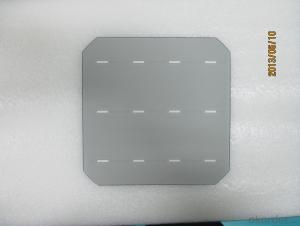Buy Small Solar Cells:156*156mm Monocrystal Solar Cell with 4.42 Watt High Efficiency
- Loading Port:
- Shanghai
- Payment Terms:
- TT or LC
- Min Order Qty:
- 1000 pc
- Supply Capability:
- 20000000 pc/month
OKorder Service Pledge
OKorder Financial Service
You Might Also Like

Monocrystal solar energy cell
type:156M
appearance:156×1565㎜±0.5mm;diagonal:R=100mm
Main fence wide:1.4-1.5mm back electrode wide:2-2.5mm
Fence line qty:90
Cell thickness:220um±20um
Eff(%) | 18.50- 18.60 | 18.60- 18.70 | 18.70- 18.80 | 18.80- 18.90 | 18.9- 19.0 | 19.1- 19.1 | 19.1- 19.2 | |||||
Pm(W) | 4.42 | 4.44 | 4.47 | 4.49 | 4.52 | 4.54 | 4.56 | |||||
Isc(A) | 8.82 | 8.83 | 8.85 | 8.86 | 8.88 | 8.9 | 8.93 | |||||
Im(A) | 8.33 | 8.35 | 8.39 | 8.42 | 8.45 | 8.47 | 8.51 | |||||
Voc(V) | 0.634 | 0.635 | 0.636 | 0.637 | 0.637 | 0.638 | 0.64 | |||||
Vm(V) | 0.532 | 0.534 | 0.534 | 0.535 | 0.536 | 0.537 | 0.538 | |||||
FF(%) | 79.3 | 79.5 | 79.6 | 79.8 | 80 | 80 | 80 |

remark:our company cells as per working current concentrate principle,separate the first and the second grade
Usage of Polycrystalline Solar Cells
Solar cells are often electrically connected and encapsulated as a module. Photovoltaic modules often have a sheet of glass on the front (sun up) side, allowing light to pass while protecting the semiconductor wafers from abrasion and impact due to wind-driven debris, rain, hail, etc. Solar cells are also usually connected in series in modules, creating an additive voltage. Connecting cells in parallel will yield a higher current; our solar cells have passed IEC Certification. With high and stable quality, our cells can greatly improve the performance of Solar Modules.
Applications of Polycrystalline Solar Cells
Assemblies of photovoltaic cells are used to make solar modules which generate electrical power from sunlight, as distinguished from a "solar module" or "solar panel". A solar array generates solar power using solar energy.
Factory Picture of Solar Cells


FAQ
We have organized several common questions for our clients,may help you sincerely:
What’s price per watt?
A: It’s depends on the quantity, delivery date and payment terms of the order. We can talk further about the detail price issue. Our products is high quality with lower price level.
Can you tell me the parameter of your solar cells?
We have different series of cells with different power output, both from c-si to a-si. Please take our specification sheet for your reference.
How do you pack your products?
We have rich experience on how to pack the panels to make sure the safety on shipment when it arrives at the destination.
Can you do OEM for us?
Yes, we can.
How long can we receive the product after purchase?
In the purchase of product within three working days, We will arrange the factory delivery as soon as possible. The perfect time of receiving is related to the state and position of customers. Commonly 7 to 10 working days can be served
- Q: What is the difference between polysilicon and monocrystalline silicon photovoltaic cells?
- In the photovoltaic technology and micro-semiconductor inverter technology today, the rapid development of the use of silicon single crystal produced by solar cells can be directly into solar energy into light, to achieve the beginning of the green energy revolution.
- Q: Have you ever been to a solar cell power generation station?
- Of course, I've been there at least 3 times.
- Q: Can solar cells be used in railway applications?
- Yes, solar cells can be used in railway applications. They can be installed on train rooftops to generate electricity, which can power various systems such as lighting, air conditioning, and communication systems. This helps reduce reliance on traditional power sources, lower operating costs, and make railways more sustainable and environmentally friendly.
- Q: Can solar cells be used for off-grid applications?
- Yes, solar cells can be used for off-grid applications. Solar cells, also known as photovoltaic (PV) cells, convert sunlight into electricity. This renewable energy source can be harnessed to power various off-grid applications such as remote homes, cabins, or even portable devices. By installing solar panels and storage batteries, off-grid systems can generate and store electricity for use when there is no access to a traditional power grid.
- Q: How do solar cells perform in areas with high levels of volcanic ash?
- Solar cells may not perform optimally in areas with high levels of volcanic ash. The ash particles can accumulate on the surface of the solar cells, blocking sunlight and reducing their efficiency. Regular cleaning and maintenance may be required to ensure the cells continue producing electricity effectively.
- Q: What is the role of solar cells in powering agricultural irrigation?
- Solar cells play a crucial role in powering agricultural irrigation as they convert sunlight into electricity, providing a renewable and sustainable energy source. By harnessing solar power, farmers can operate irrigation systems efficiently, reducing reliance on fossil fuels and minimizing carbon emissions. This enables them to irrigate crops effectively, improving yields and ensuring sustainable agricultural practices.
- Q: Can solar cells be used in powering medical devices?
- Yes, solar cells can be used in powering medical devices. Solar cells convert sunlight into electricity, which can then be used to power various medical devices such as portable diagnostic tools, wearable health monitors, or even small medical implants. This technology offers a sustainable and reliable energy source, particularly in areas with limited access to electricity or during emergencies where traditional power sources may not be available.
- Q: What is the payback period for solar cell installations?
- The payback period for solar cell installations typically varies depending on factors such as the cost of installation, local electricity rates, and available incentives. On average, it ranges from 5 to 10 years, but in some cases, it can be as short as 3 years or as long as 15 years.
- Q: How much electricity can a solar cell generate?
- The amount of electricity a solar cell can generate depends on various factors such as the size and efficiency of the cell, the intensity and duration of sunlight, and the environmental conditions. On average, a standard solar cell can generate around 1 to 2 watts of electricity per square meter under optimal conditions.
- Q: Can solar cells be used for water heating?
- Yes, solar cells can be used for water heating. Solar water heating systems use solar panels, which contain solar cells, to capture energy from the sun and convert it into heat. This heat is then used to warm water for various applications, such as domestic hot water or space heating.
Send your message to us
Buy Small Solar Cells:156*156mm Monocrystal Solar Cell with 4.42 Watt High Efficiency
- Loading Port:
- Shanghai
- Payment Terms:
- TT or LC
- Min Order Qty:
- 1000 pc
- Supply Capability:
- 20000000 pc/month
OKorder Service Pledge
OKorder Financial Service
Similar products
Hot products
Hot Searches
Related keywords




























